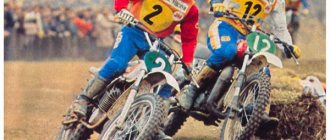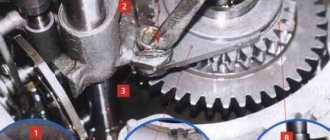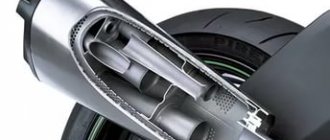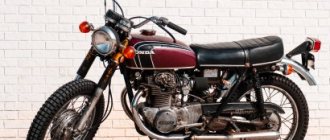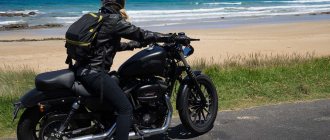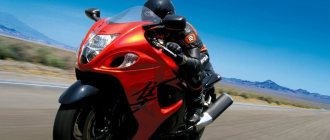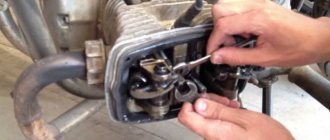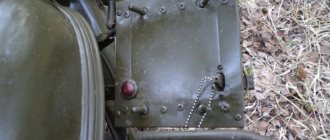Appearing at the beginning of the war years, in 1941, the M 72 motorcycle was copied from the successful German model BMW R71 by the standards of those years. Soviet engineers made a number of changes to the design, making the frame more torsionally stronger, and decided that it would be a great idea to equip the bike not only with a sidecar, but also with weapons. As a result, this steel horse of the Red Army was classified as light armored vehicles, and for a long time was used exclusively for military purposes. It went on sale for free only in the 50s of the 20th century, in a civilian version. The bike was produced at various import sites - MMZ in Moscow, KMZ in Kiev, Irbit in the Urals... It was this bike that served as the prototype of the Ural motorcycle, and of the 8,500 copies some are still on the road.
Design
During the war years, no one thought about the appearance of motorcycles, so the M72 motorcycle turned out the way it should have been - angular, iron and brutal. This fiend of Soviet industry in those years was produced exclusively with a cradle and a machine gun! A civilian version began selling in 1955, featuring a modified engine and minor styling changes, but still capable of mounting weapons if necessary. All owners were even required to register their property with the military registration and enlistment office, since in case of war they could be requisitioned for army needs.
Specifications
Having bought five copies of the BMW P71, Soviet designers took them apart piece by piece and copied them completely without making virtually any changes. The technical characteristics of the bike were fully consistent with their time - the German original worked well in the Wehrmacht, and the Soviet copy in the Red Army. Officially, it was called a “military motorcycle”, and fully corresponded to this description.
Engine
All versions were equipped with a 746 cc 4-stroke 2-cylinder air-cooled boxer engine . For its time it was not bad - 22 hp. at 4600 rpm , and the engine is distinguished by confident traction at low speeds. Even with a sidecar, he is able to pull the bike out of the mud. In a single version, the IMZ M 72 is capable of reaching speeds of up to 110 km/h, and with a sidecar – up to 90 km/h.
Transmission
4-speed transmission for the 40s . Gears can be changed using either a pedal or a lever located to the right of the gas tank, but in modern technology this design has not been used for a long time. It will most likely not be easy to get used to it.
Chassis and brakes
This bike featured a high-tech duplex steel frame and a telescopic fork, which was new at the time (although some examples were equipped with a lever fork). Torque is transmitted to the rear wheel using a driveshaft. The brakes are the most primitive, drum, but they are not afraid of sand or dirt.
Electronics
The designers equipped the M 72 motorcycle with a 6-volt battery and a 45-watt generator. He got the most standard ignition, battery-powered, although the sports versions were equipped with a magneto. Some enthusiasts convert the bike to 12V, but such intervention in the design inevitably entails a lot of other modifications.
Weight and dimensions
The weight of the M72 without a sidecar reaches 225 kg, and with it exceeds 350 kg. Cast iron cylinders, a massive frame, the absence of any plastic - all this made the bike very heavy. The saddle height is moderate, 790mm in stock condition, so most bikers can reach the ground with their feet without any problems.
Controllability
With a sidecar, the bike moves along the roads with the grace of a hippopotamus, just like later Urals. Without it, it steers much better, but you still need to be careful. A rough, bulky frame and extremely simple suspension do not contribute to good maneuverability.
Fuel consumption
The declared gasoline consumption of the M 72 motorcycle is about 7 liters per 100 km, but the actual values directly depend on the condition of the particular instance. The gas tank holds as much as 22 liters, so the bike’s power reserve is not bad in any case, especially since it can run on any gasoline, regardless of its quality and octane number. In those years when it was produced, no one had heard of AI-92, let alone higher octane fuels.
Story
In the USSR, the decision to produce a special army motorcycle was made at the beginning of 1940. Under the leadership of N.P. Serdyukov, who from 1935 to 1940 underwent an internship at the BMW plant[3], a specialized design bureau for heavy motorcycle construction was created on the basis of the Moscow experimental one. The BMW R 71 (BMW-750)[4][5] motorcycle, which by that time had proven itself well in the Wehrmacht, was chosen as a sample for complete copying. Five motorcycles were purchased anonymously from Sweden. Since the spring of 1941, the production of a motorcycle under the M-72 brand was launched at the Moscow Motorcycle Plant (MMZ). Through cooperation, ZIS developed documentation and supplied engines, KIM (now AZLK) - gearboxes, GAZ - the driveshaft and sidecar. The Moscow Motorcycle Plant produced motorcycles until 1951. Another production base was the Kharkov plant; the Kiev Medical Instruments Plant supplied it with engines. The production of the M-72 was also entrusted to Leningrad. On February 25, 1942, M-72 motorcycles began to be produced in Irbit, where equipment from MMZ, KiM, ATE-1, and the ZiS engine workshop were evacuated. The main design bureau also moved from Moscow to Irbit. It was headed by Alexander Minovich Fedorov, among the designers were I. I. Okunev, N. A. Kukin, V. V. Bekman, testers S. I. Karzinkin and B. V. Zefirov. At the same time, the production of M-72 motorcycles was launched by the Gorky Motorcycle Plant. In parallel with IMZ, starting in 1951, the Kiev Motorcycle Plant (KMZ) began making M-72 motorcycles. Later he embarked on his own path of design development. There were no differences in design (and even in emblems!) among M-72 motorcycles produced in Moscow, Irbit, Leningrad, Kharkov or Gorky. Since 1955, M-72 motorcycles began to be sold to the public. The civilian version of the IMZ plant was distinguished by: an improved engine, reinforced wheels and frame, torsion bar suspension for the sidecar wheels, a new color scheme and the inscription “Irbit” on the tank. However, all these civilian motorcycles were registered with the military registration and enlistment office and were subject to requisition in wartime. 8.5 thousand motorcycles were produced.
Repair and tuning
Like all Soviet equipment, this motorcycle is distinguished by its simplicity of design and maintainability. You can maintain and repair it yourself using a minimal set of tools.
Repair
To repair the M72, any garage and a suitcase with tools will do for 3 thousand rubles. The network is full of detailed instructions about all service operations and “diseases” of these bikes, so understanding all the nuances will not be difficult. But they are not highly reliable - in wartime, the equipment did not last long, and making it durable was unprofitable, so all surviving copies of the motorcycle require regular attention and hands-on use.
Spare parts
Original spare parts for this two-wheeled rarity can be found on message boards and owner forums. Many units are suitable from Ural and M61, but not all. The cost of original spare parts varies depending on their prevalence and condition, and can be either cheap or very impressive.
Tuning
There are few M 72 motorcycles left in the world in a condition that can at least conditionally be called alive. Therefore, all those who like to take an ancient bike and build from it another “real chopper” in the best traditions of the “Red Lenin” collective farm, armed with an angle grinder and welding, should be excommunicated for life from the garage and forever deprived of category “A”, and should not be allowed near motorcycles even on a gun shot. Such a rarity should not be tuned, but restored and restored.
Modifications
The M72 was produced in two versions, with and without a sidecar, and the side trailers were equipped with mounts for on-board weapons. If desired, the cradle can be detached, and the motorcycle will not lose its ability to move even without any modifications. During production, minor updates were made, but there was only one major change, in 1956 - the M 72M model went onto production lines. It featured a new cradle, a reinforced reverse gearbox, a modified engine and improved wheels, which became stronger thanks to newly secured spokes.
There were also several sports modifications, but finding them now is almost impossible. Enthusiasts, however, can try:
- M 72K , a lightweight cross-country version with a forced engine. Produced in small batches.
- M 75M . It was a modified version of the previous modification, with a sidecar and an overhead valve engine. Sometimes mistakenly called M72M.
- M 76 . A single (without cradle) version of the regular M 72 motorcycle, also with an overhead valve engine, similar to the one installed on the M 61.
- M 80 . Almost a one-off model, created specifically for competitions.
Motorcycle's sporting background
Powerful, reliable, unpretentious, the M-72 motorcycle has proven itself both in the military and in civilian life. He also had his share of sporting achievements. It participated in various competitions held by DOSAAF and was produced in several sports modifications:
- M-72K. A lightweight version supplied to sports clubs. Engine power, due to changes in valve timing and additional adjustment of parts, was increased to 30 liters. With. The motorcycle was used for motocross competitions.
- M-75K. He competed in road races with a sidecar. The heavily modified engine was equipped with cylinder heads with overhead camshafts and a transmission with closely spaced gear stages.
- M-76. This is a further development of the M-75K modification. The engine received a dry sump and magneto ignition.
- M-80. A record-breaking motorcycle on which Evgeny Gringaut, Honored Master of Sports of the USSR, in 1947 broke the all-Union speed record in the category for motorcycles with an engine capacity limit of up to 750 cc. cm. He accelerated to 172 km/h.
Today, the M-72 motorcycle, in good condition, is of interest to collectors. Its price depends on the completeness and number of original parts. High-quality restoration of such equipment will bring much more dividends than the most advanced tuning. After all, no matter what you say, this is our story.
Previous entry Motorcycle Ural - all modifications
Next entry Installing electronic ignition on a Ural motorcycle
Advantages and disadvantages
It is difficult to talk about strengths and weaknesses when we are talking about a motorcycle that was produced 50-70 years ago. For its time and its purposes, the M72 was good, but a lot has changed since then.
Advantages
- Reliable 4-speed transmission , advanced for its time.
- -road ability .
- Phenomenal maintainability . You can literally fix a bike with a hammer and a screwdriver.
Flaws
- Insufficient frame rigidity on early copies. When the stroller is loaded, this can lead to the frame twisting, especially when driving off-road.
- Frequent breakdowns . Soviet designers did not put much resource into military equipment, since during the war it was “consumable”.
- Difficulty finding spare parts , especially original ones.
Owner reviews
When I was a child I had an M72, my first motorcycle. What have I done with it... If I had known then that it was such a rarity, I would have treated it differently. But I still remember with warmth, it was he who instilled in me a love for bikes and turning nuts. Now I would never sell it, sometimes I even think about looking for an option for sale so I can restore it myself, but that’s just a dream. Ivan, Podolsk.
A real Soviet monster!!! No match for the late Urals, which fell apart on the move ten years after their release. The M-72 is like the T-34 tank, only with two wheels, the same cast iron, indestructible and repairable. Dmitry, Tyumen.
The M72 was inherited, it has been in the garage since the late 90s, and over the last couple of years I have been slowly restoring it. The bike is already driving, the original stroller has been purchased and prepared for painting, but the process is going slowly, I only work on it on weekends sometimes, I just don’t have enough time. So far, about 120 tons have been spent on spare parts and work, I think it will take the same amount, but in the end there will be a motorcycle restored to 100% original, with the exception of tires - at least put it in a museum. Favorite weekend toy)) Alexander, Rostov-on-Don.
Part two: Construction. Speculation. Errors
Speculation No. 1. Breather (erroneous)
One of the first mistakes and conjectures was the theory of a broken oil seal on the HF.
The disassembly of the engine began with the clutch, which, despite 30 years of oblivion in the garage, was still covered in oil. Subsequent disassembly showed that oil was spread over all clutch discs. At that moment, it was logically assumed that the KV oil seal had broken, and here’s why.
Having removed the front timing cover, we saw a breather installed on the camshaft gear not through a slot behind a pin on the gear, but through a groove on the body of the breather (pretty beaten by the pin).
Logically, we assumed that because of the breather, the engine broke through the KV seal, we calmed down. Moreover, according to the stories of the owner of this engine, the engine on the stand did not perform well, it filled the clutch with oil, and the tests were cancelled. Then they completely forgot about the engine, and so it ended up in the garage near Dmitrov.
Let's look at the design of the breathers on the timing cover.
In the photo above there is a type of cover for a HF generator (according to rumors from Java). In the first photo in this article, you can also see that there are two breather holes on the cover, at an angle of 180 degrees to each other.
Here's another photo:
Now let’s remember how the breather channel is located on a standard Ural? Right. It is either located at the bottom left or diametrically at the top right.
Those. If the breather had been positioned “correctly” in the engine, the engine would definitely not have been able to vent in the right place and at the right time. The displacement of the breather in the engine was correct, and it was precisely for the horizontal arrangement of the breather channels, but no one saw the point in sharpening the breather for single engines, and therefore it was installed not by the slot, but along the groove (first “finishing it with a file”).
Speculation No. 2. Flywheel
The flywheel is a work of art and the gloomy geniuses of the designers. Lightweight, chiseled, for 9 standard clutch springs, versus 6 in stock. Diaphragm? Pfff. hold my beer.
look further:
Who saw that the flywheel has two grooves? But they exist. And why?
Let me explain. The 750 modern crankshaft is secured against displacement in the rear support by two locking rings. The outer one holds the 208th bearing in the support, the inner one holds the bearing by the crankshaft journal.
The 650th crankshaft in the rear support is not fixed at all, and it is believed that the rear landing of the KV is floating.
So... The liter flywheel was made for the 650 engine, or more precisely for cross-country engines based on the M-72/M-61 crank and others like them. As an option for the same Cross-750 and earlier sports variants.
What could be simpler? Put connecting rods from the Economic Council on the KV from the M-72, and here you have a 750 in the dimensions of the M-61 and others like them.
But it didn’t work with the K-1000, because... the crankshaft was already in the overall dimensions of a modern 750. Well, that's right! Why not sharpen new flywheels for it?!? As a result, the elbow was machined to fit the landing dimensions of the 650 flywheel. But it was not there!
The internal retaining ring must hold onto something, and it is not possible to grind the entire elbow cone all the way through. But even here they found a way out. The missing depth in the landing of the flywheel on the cone was machined into the flywheel itself, making, as it were, two conical landings with the transition from the smaller 650th to the larger 750th.
Speculation No. 3. Rear support
The lightest, seamless. Beautiful, at least eat from her. Not long ago I saw a similar one, but only for the 650th generation. Apparently for cross-country such supports were the rule rather than the exception.
The size of the support is completely similar to modern mounts for 750 engines. There are a number of differences in the diameter of the oil channels, but this is not significant.
And, alas... The support is not titanium. Aluminum alloy, by the standards of the 70s - space-grade and nothing more. I still drive it to this day. I see no reason to change to a modern one.
The support is attached to the crankcase with M7x1 bolts. On 650s the bolts are M6x1. On modern 750s M8x1.25 How, what, where did the M7x1 bolts come from…. unclear. Apparently they understood that the M6 bolt was rather weak, but they didn’t want to resharpen the crankcase for the M8. Well, we cut a thread on top of M6x1 for M7x1. It's also easier...
Speculation No. 4. Carter
Also on the website https://imz1000cc.narod.ru/ there was a detailed description of the K-1000 engine with all the ensuing speculations and fantasies. I quote:
As the autopsy showed, this is a regular crankcase from the Ural M66 or earlier with welded areas for the cylinders and a cut off generator mount.
So this is not true. The M66 crankcase probably should have been 6-volt and had the characteristic surge of the generator support.
The author from https://imz1000cc.narod.ru/ and I have nothing like this.
The crankcase, at least mine, has the remains of a part number casting, where IMZ-8.101 is clearly read..... Which means that the crankcase was taken from a serial M67 engine
The platforms for the cylinders here are really welded “in a dirty way”
The cylinders simply wouldn’t fit differently for the 88th piston... apparently.
On my M-100 with a 92mm piston, pads were welded onto the crankcase from the M-63 in exactly the same way:
It is worth noting here that the Irbitsky plant denies these Liters, citing the fact that this was done in Serpukhov. History will judge us.
Now, children, feel all the pain...
The M67 had an oil filter, and the entire oil system was designed for it as standard... And guess what? Oil channels were made in the crankcase WITHOUT an oil filter, despite the fact that all the castings for the filter in the crankcase were... Pain, as it is.
Further. When welding on a platform for the right cylinder, there simply wasn’t enough space on the stock 650 crankcase and the flywheel cavity opened up. It was also welded “on the forehead”:
And here's another thing. How to install a 750 crankshaft into a 650 crankcase? The front supports are different, and the bearings are also different. 208th for the 750 versus 207th for the 650cc..
Right! We weld the meat and mill it under the support of the 208th bearing. By the way, the support is exactly like on modern 750s.
Speculation No. 5. Pushrods/rods/rocker arms/timing
The timing belt on the engine is standard. Suitable for all Urals. I drove my own one, but it rattled terribly. Then he switched to Duke - it was eaten due to lack of oiling. Now the timing belt is a model of the 19th year. Taiwan. The look and sound of the engine is better than the Dukes. They don't rattle, they don't howl.
Camshaft:
RV for round pushers, with a thin gear. The ignition spout is shorter than stock. According to rumors there was a curtain and a Hall sensor with manual advance. It is not clear where the coil was. The camshaft is made according to the model of modern “mountain” RVs with a rear support for a roller bearing. Completely interchangeable with modern “mounted” and “injection” RVs.
By the way, the front cover of the 205th bearing is made with a “sample” like on “old” engines with T-shaped pushers. Most likely because the crankcase was originally made to fit the old pushers. (correct me if I’m wrong, but on crankcases for round pushers, the crankcase has a protrusion for the 205th bearing and the cover is flat)
The pushers on the motor are their own. Most likely reground from stock round pushers. The pusher is shorter than the original one and has a groove, apparently made because the rod-pusher interface is located inside the body of the pusher. And in order to minimize flaring and biting of the pusher in the body, a groove appeared.
The push rod is longer than the standard 750 rod.
The rocker arms are your own. On needle bearings. In the photo next to the usual ones from 750
Similar models
- IMZ M 61 . Direct descendant of the M 72, produced for 4 years, from 1957 to 1961. Equipped with an overhead valve engine instead of a lower valve one.
- Ural M 62 . Produced at the Irbit plant from 1961 to 1965, it was distinguished by improved ignition and an increase of 2 hp. motor power.
- Ural-2 M 63 . The first Soviet heavy motorcycle with the then advanced pendulum rear suspension with spring shock absorbers. Produced from 11963 to 1971.
Part one. Introductory.
When, in September 2011, by an incredible coincidence, I nevertheless became the owner of my first (and, by the way, not the only) Ural Liter, a feeling of euphoria overwhelmed me to the very core. It would seem: this is the dream of every opposition member. The very fact of owning this miracle, produced in the amount of 20 copies (a similar engine with a number exceeding 00020, it seems, has not yet been found) exalted all aspirations and dreams, and hopes, and fantasies... to a qualitatively new level. Can you imagine the level of my heart rate at that moment? Mine turned out to be number 00013 (“if the cook is not lying to us,” I was lucky enough not only to touch, but also to possess, another Ural Liter with a similar number. Moreover, if you believe the same “cook,” then the K-1000 with number 00001, also did not escape my hands) I’ll make a reservation right away, all the engines from the M-73 “cycle” missed me.
This is how I saw a liter engine for the first time on Auto.ru
The story of the removal of the engine is described in detail here
Almost immediately the engine went to capital stock at VasePZ and I almost didn’t know the details of its repair, the features of its design, nuances and other things. The engine immediately showed wear and scuffing on the CPG, a broken crankshaft oil seal, and all the gaskets there for so many years had come to an end a long time ago.
FAQ
- There is my grandfather’s M 72 motorcycle in the garage, but the engine is dead and cannot be restored. Is it possible to put an engine from the Urals into it? With a number of serious modifications, it’s possible. But it will be much easier to try to find an overhead valve engine from the M 61; it will fit into the frame with less difficulty.
- How much can you sell an M72 on the move for? It starts, drives, and is in farm condition. If most of the original spare parts are preserved, then you can count on a price of up to 80-100 thousand. Another thing is that finding a connoisseur willing to buy a bike for restoration can be difficult.
- The oils for which it is designed have not been produced for a hundred years. Which ones are better to use? Any inexpensive motorcycle oil will do. The bike is not picky in this regard.
In service and in civilian life
Until the mid-fifties of the 20th century, the M-72 motorcycle was inaccessible to the ordinary population. It was supplied to military units and qualified by the GABTU of the Red Army as armored vehicles. It had places for installing small arms. Apparently, Soviet military leaders appreciated the mobility of motorized rifle formations.
The motorcycle also performed well in the service of the Ministry of Internal Affairs. But when the needs of the army and police were met, this equipment became available to the civilian population. However, let’s say right away that the price of the M-72 was quite high.
Conclusion
The M 72 motorcycle is a wartime product . Even from the photo it is clear that it was designed for one purpose - to be produced as quickly and cheaply as possible. Now there are very few of these veterans left, and if you get your hands on this bike, the best solution would be to either restore it or put it in the caring hands of people who will cope with this task.
Specifications
| Maximum engine power: | 22 l. With. at 4,600 rpm HP |
| Working volume: | 746 cm3 |
| Motor type (cylinder arrangement, number of strokes): | Opposed |
| Number of cylinders: | 2 |
| Number of valves: | |
| Intake type (Injector / Carburetor): | |
| Bore and stroke: | |
| Starting system (Electric starter, kick starter): | |
| Maximum speed in km/h: | 95 km/h |
| Cooling system: | Air |
| Transmission (gearbox): | 4-speed |
| Clutch (Dry / Wet): | |
| Drive unit: | Cardan |
| Frame: | Steel |
| Chassis | |
| Suspension (front/rear travel): | |
| Brakes (Front/Rear): | |
| Wheels / Tires / Rubber: | |
| Dimensions and weight | |
| Dimensions (Length / Width): | |
| Seat height: | |
| Ground clearance: | |
| Curb weight: | |
| Wheelbase: | 1430 mm |
| Weight: | 225/350 kg |
| Fuel tank capacity: | 22 l. |
| Battery capacity: | |
| Year of release: | |
| Country of Origin: |
M-72
This entry is also available in: English Chinese
[/container] [/content_band] Based on the pre-war BMW R-71, the Soviet M-72 heavy motorcycle was produced from 1941 until the mid-1950s. Its development began in 1939, when the Soviet government, concerned about Hitler's ambitions to expand German territories, began rearming the Red Army. The Germans were quite successful in developing heavy motor vehicles, so in order to save time, it was decided to “adapt” the existing design solution.
Minister of Foreign Affairs of the USSR V.M. Molotov organized the secret purchase of five BMW R-71 motorcycles from Sweden and Soviet engineers got to work. In the winter of 1941, the Main Armored Directorate of the Red Army (GABTU KA) conducted field tests of the new M-72 motorcycle. Since the spring of 1941, the production of a motorcycle under the M-72 brand was launched at the Moscow Motorcycle Plant (MMZ). Through cooperation, ZiS developed documentation and supplied engines, KIM (now AZLK) - gearboxes, GAZ - driveshaft and sidecar. The Moscow Bicycle Plant produced motorcycles until 1951. Another production base was the Kharkov plant; the Kiev Medical Instruments Plant supplied it with engines. Leningrad also took up production of the M-72. On February 25, 1942, M-72 motorcycles began to be produced in Irbit (see Irbit Motorcycle Plant), where equipment was evacuated from MMZ, KiM, ATE-1, and the ZiS engine workshop. The main design bureau also moved from Moscow to Irbit. It was headed by Alexander Minovich Fedorov, among the designers were I. I. Okunev, N. A. Kukin, V. V. Bekman, testers S. I. Karzinkin and B. V. Zefirov.
The design of the BMW R-71 was aimed at mass production and simultaneously contained many technical innovations that were not used on Soviet motorcycles. This is a duplex frame, foot gear shift, spring suspension of the rear wheel, telescopic front fork, cardan transmission, each cylinder is powered by an independent carburetor.
The opposed arrangement of the cylinders in the engine ensured not only its good balance, but also a low center of gravity of the entire motorcycle. For the M-72 it lay at a height of 592 mm.
All auxiliary components (breaker, oil pump, generator) on the M-72 were driven by gears, the cast-iron cylinders were coated with anti-corrosion heat-resistant black varnish, the crankshaft connecting rod bearings were roller, and the main bearings were ball bearings. The connecting rods did not sit on a common neck, but each on its own.
Therefore, the left cylinder along the machine is shifted forward by 39.2 mm relative to the right one. In the interests of reducing the length of the engine crankcase and, consequently, its weight (with gearbox it weighed 75 kg), the crankshaft on the M-72, like that of the BMW R-71 prototype, is made double-bearing, and its middle cheek is relatively thin (18 mm ). When this engine was boosted, when the load on the crank mechanism increased, this cheek broke, although it was made of high-quality steel (ZOKHMA or ZOKHGSA).
The motorcycle was equipped with bags for ammunition and spare parts, and special brackets with a rotating device for securing a light machine gun (swivel). The Degtyarev machine gun was attached with a bipod to the swivel plate, which made it easier to transport and made it possible to fire from a standstill and even on the move. Tubular brackets in front and behind the sidecar, into which the swivel was inserted, made it possible to fire both along the motorcycle and backwards. Also, in very limited quantities, the troops received modifications with an 82-mm mortar installed instead of the sidecar body.
Before IMZ switched to the improved M-72M at the end of 1955, the motorcycle was gradually modernized. So, in 1949, the plant introduced a double air filter - mesh and inertia-oil, more efficient than the previous mesh. Since 1950, instead of the RR-1 relay-regulator, motorcycles began to be equipped with a new RR-31 device. Then, in 1952, the improved G11A generator was introduced. Its power, both in its predecessor (G11) and in the subsequent model (G414), remained, however, unchanged. Throughout the years of production of the M-72 and its successors, the design of the K-37 carburetor, tire size (3.75-19) and a number of other components did not change.
Over the entire period, more than 330,000 M-72 motorcycles were produced.
Based on the article “Heirs of the BMW R-71”
| Manufacturer | Irbit Motorcycle Plant, Irbit, USSR |
| Years of manufacture | 1941 – 1956 |
| Quantity, pcs | more than 330000 |
| Price | |
| Cost in modern prices |
| ENGINE AND TRANSMISSION | |
| Type | 2-cylinder, opposed |
| Engine volume, cm3 | 746 |
| Piston diameter and stroke, mm | 78 x 78 |
| Power | 22 hp at 4600 rpm. |
| Ignition | generator G11 |
| Carburetor | K-37 – 2 pcs. |
| Battery | 3 MT-14, 6V |
| Clutch | double-disc dry |
| Transmission | 4-speed |
| FRAME AND WHEELBASE | |
| Frame type | double tubular |
| Front suspension | spring telescopic with hydraulic shock absorber |
| Rear suspension | spark plug spring without shock absorbers |
| Brakes | drums |
| Wheel sizes | 3.75 x 19 |
| DIMENSIONS | |
| Length, mm | 2 380 |
| Width, mm | 1 590 |
| Height, mm | 1 000 |
| Wheelbase, mm | 1 400 |
| Ground clearance, mm | 132 |
| Seat height | 790 |
| Weight, kg | 336 |
| Gas tank capacity, l | 22 |
| Maximum speed, km/h | 85 |
| Range, km | 314 |
[clear] [lightbox selector=”.motorcycle-lightbox” deeplink=”false” opacity=”0.875" prev_scale=”0.75" prev_opacity=”0.75" next_scale=”0.75" next_opacity=”0.75" orientation=”horizontal” thumbnails= "false"]
